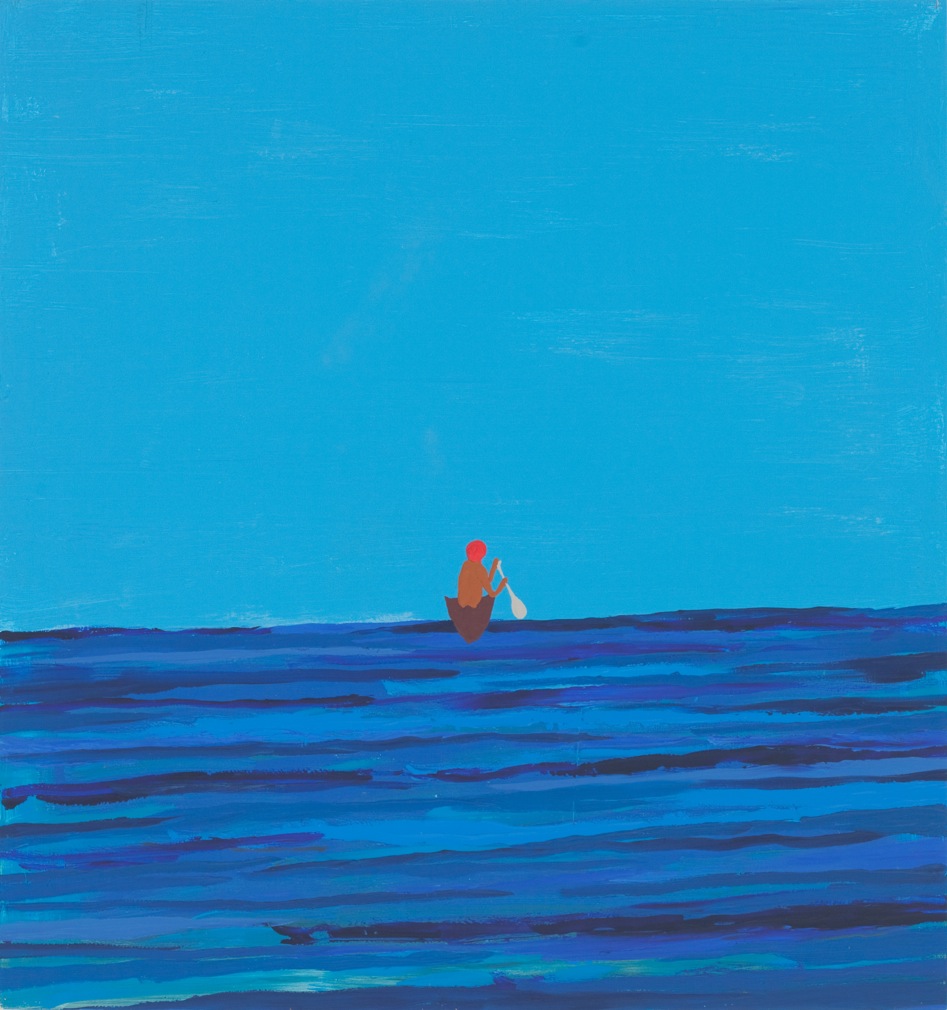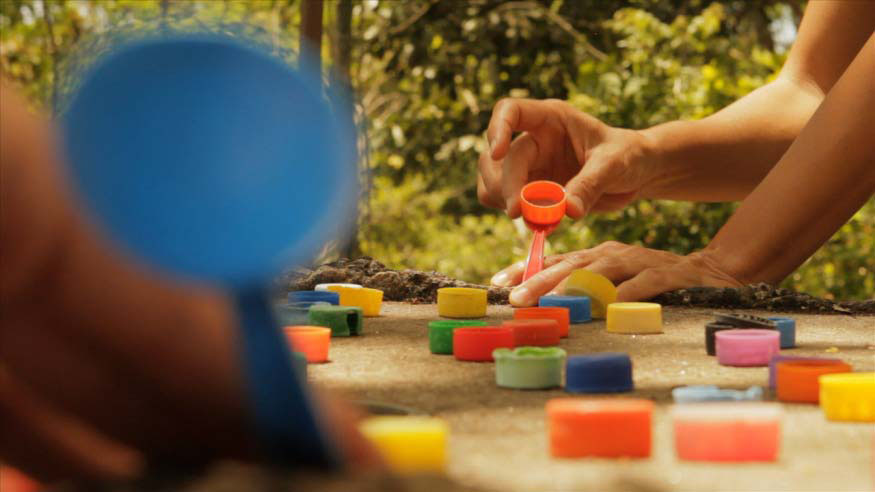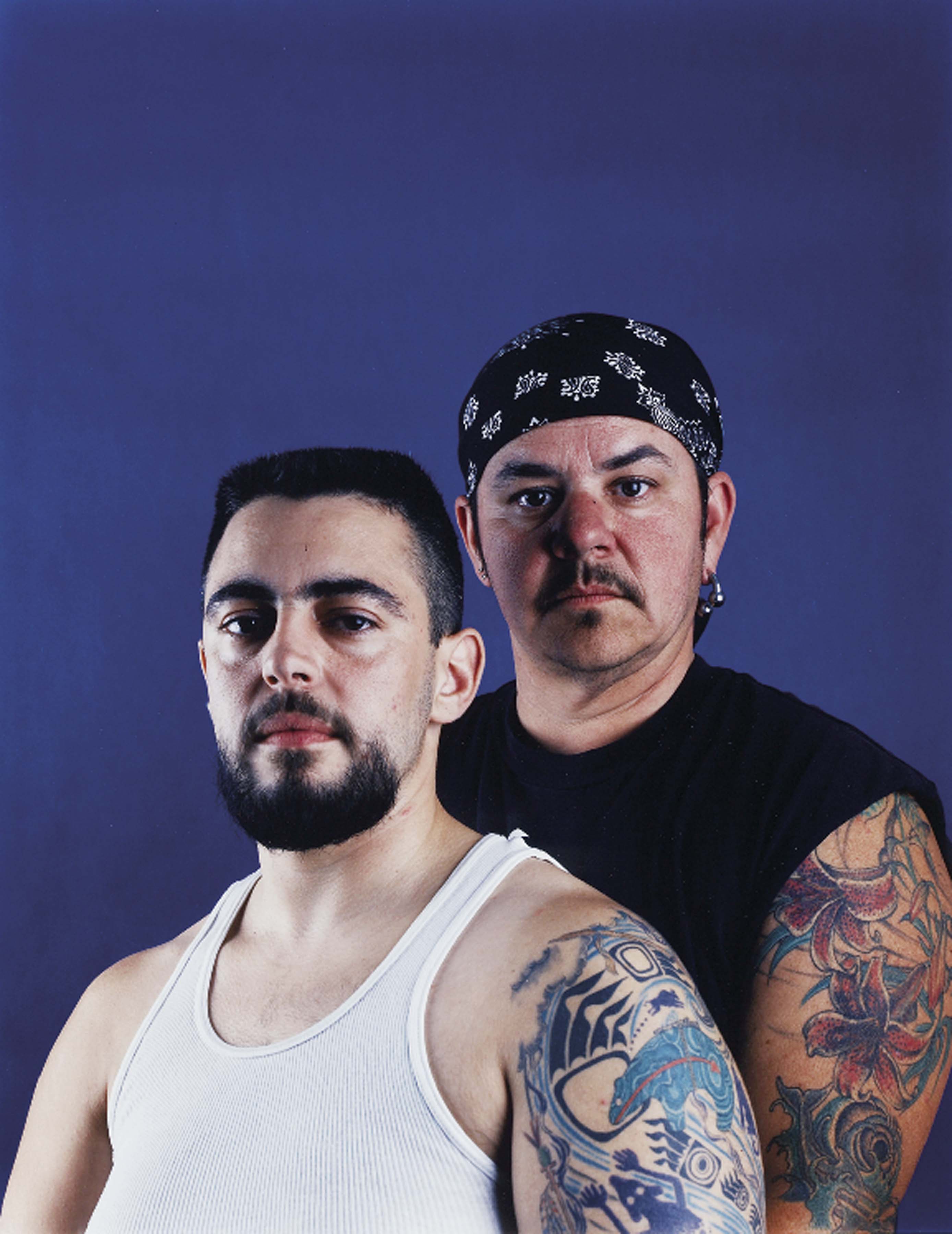
© » KADIST
Chris Johanson
Chris Johanson’s Untitled (Painting of a Man Leaving in Boat) (2010) pictures a canoe drifting toward an off-kilter horizon line, which demarcates the cobalt sea from the cerulean sky. An orange-haired figure, oar positioned in mid-stroke, looks ahead—whether toward an edge or an infinite expanse, it is impossible to tell. Echoing a trope that recurs in Greek epic poetry, transcendental painting, and current-day reality television, the character is alone with nature.

© » KADIST
James Welling
#17 Pink is a photogram, a photographic image produced without the use of a camera. Here, the artist placed plumbago blossoms on a sheet of eight-by-ten-inch film and exposed it to light. The negative was then projected onto Kodak Metallic Endura paper through a color mural enlarger and cooler filters to produce the multicolored print.

© » KADIST
Scott Reeder
Reeder’s works often start with language—and his Pasta Paintings are no different. After the phrase for the title came through his head, the artist set about trying to figure out how to make a mark with pasta. These paintings are the result, made using the pasta as something of a stencil, with the paint being applied after the noodles have been scattered on the painting’s blank surface.

© » KADIST
Andrea Bowers
Bowers’ Radical Hospitality (2015) is a sculptural contradiction: its red and blue neon letters proclaim the words of the title, signaling openness and generosity, while the barbed wires that encircle the words give another message entirely. Meant to hang from the ceiling, Bowers’ neon is further weighed down by long wind chimes made of aluminum pipes and wooden wind catchers that drip unsteadily from their anchors. Poetic but frantic in its juxtapositions, Bowers’ work captures a certain paradoxical energy that echoes the current political climate—it is hopeful but hindered, cacophonous but well intentioned, uncertain but ominous.

© » KADIST
Ben Shaffer
Ben Shaffer’s Ben Deroy (2007) is part performance, part self-portrait, and part spiritual vision. Often the artist works with the motifs of the counterculture and contemporary non-religious spiritualism. The figure hangs suspended—seemingly ascending—animation.

© » KADIST
Donna Conlon and Jonathan Harker
In Tapitapultas (2012), Donna Conlon and Jonathan Harker comment on mass consumerism and pollution by way of a game they invented. The artists used disposable spoons as catapults to shoot thousands of plastic bottle caps at a hole in a concrete platform. The platform was once part of a U. S. military installation in the Panama Canal Zone, and it is now an observation deck in a nature park.

© » KADIST
Juliana Huxtable
Herculine’s Prophecy by Juliana Huxtable features a kneeling demon-figure on what appears to be a screen-print, placed on a wooden table, which has then been photographed and digitally altered to appear like a book cover, with a title and subtitle across the top, and a poem written across the bottom. This composition is stuck to a metal plate by a series of button magnets, with interjecting phrases on them. The juxtaposition between the mysogynistic, almost puritan poetry that stripes across the bottom and the powerful crouching pose that the femme demon assumes inverts the hegemonic text , instead creating a space of alterity.

© » KADIST
Chris Johanson
Chris Johanson’s paintings, sculptures, and installations break down everyday scenes and commonplace dramas into colorful forms; the darkest sides of humanity are invoked with humor. The works comment on subjects such as capitalism, consumerism, the art world, and therapy. The triptych I Am a Human, Abstract Foil, No Humans IV (2004) is a meditation on the cosmos.

© » KADIST
Andrea Bowers
Drawing & Print (Drawing & Print)
The small drawings that comprise Study from May Day March, Los Angeles 2010 (Immigration Reform Now) and We Are Immigrants Not Terrorists are based on photographs taken at a political rally in downtown Los Angeles in which thousands of individuals demonstrated for immigrants’ rights. The protesters and their supporters carried signs and wore t-shirts whose messages are highlighted in the drawings. However, in them, Bowers isolates the images of the protesters from the multitude that surrounds them in the original photographs, and, therefore amplifies their messages.

© » KADIST
James Welling
Welling employs simple materials like crumpled aluminum foil, wrinkled fabric and pastry dough and directly exposes them as photograms, playing with the image in the process of revealing it. Although Welling’s approach to photography is more conceptually oriented than poetic, the resulting image in Stowe (a direct photogram of a crumpled piece of cloth) somehow resembles a curtain, perhaps suggesting that an artificial even fictive component in photographic representation. While the curtain might echo other imagery, Welling’s approach is not allegorical but rather abstract in a way that reinforces the materiality of the object.

© » KADIST
Chris Johanson
Apartment on Cardboard (2000) is an exterior view of an abstracted apartment building. Viewers unwittingly become voyeurs, peering through the rectangles that stand for windows and observing the residents therein, who ponder questions both mundane and existential: “Where is Ron now?” and “What have I become?” The queries and characters are treated democratically—not judged, praised, or subjected to hierarchy. While their thoughts are specific, the painting captures a universal urban activity: looking across to the building next door and wondering about its residents, all the while knowing that they have probably looked over and wondered about us, as well.

© » KADIST
Shahzia Sikander
The Last Post was inspired by Sikander’s ongoing interest in the colonial history of the sub-continent and the British opium trade with China. In this animation, layers of images, abstract forms, meaning, and metaphorical associations slowly unfold at the same time that more visual myths are created. The identity of the protagonist, a red-coated official, is indeterminate and suggestive of both the mercantilist policies that led to the Opium Wars with China and the cultural authority claimed by the Company school of painting over colonial India.

© » KADIST
Catherine Opie
Although best known as a provocateur and portraitist, Opie also photographs landscapes, cityscapes, and architecture. The Freeway Series was developed in 1995, right after the artist’s inclusion in that year’s Whitney Biennial. As if suggesting that her work should not be restricted to being seen through overtly political or activist lenses, this series lends insight into the city of Los Angeles via its most characteristic urban feature: its highways.

© » KADIST
Catherine Opie
Like many of Opie’s works, Mike and Sky presents female masculinity to defy a binary understanding of gender. The very practice of being photographed raises many complex issues around gender performance and the relationships between an inner self and an outer public persona. Even though Mike and Sky are cropped and obscure one another, many of their choices for self-presentation—as emphasized by their tattoos—remain visible.

© » KADIST
Catherine Opie
Alistair Fate (1994) depicts, presumably, a member of the LGBT community. Catherine Opie is known for her portraits of LGBT, queer, and outsider people; she intends them to come off not as shocking or different, but as human despite their deviance from societal norms. This image is one of several works by Opie in the Kadist Collection that show marginalized people, filtered through the artist’s signature appropriation of formal and classical portraiture in the interest of both documentation and reframing.

© » KADIST
Catherine Opie
In this work, a woman sits on a couch with her shirt pulled up to expose her pierced nipples, which are connected by a chain. She wears an expression of both pleasure and intensity as she points a gun at someone or something outside of the frame. Raven (gun) (1994) is not so much threatening as full of sexuality and potential energy.

© » KADIST
Catherine Opie
Catherine Opie’s candid photograph Cathy (bed Self-portrait) (1987) shows the artist atop a bed wearing a negligee and a dildo; the latter is attached to a whip that she holds in her teeth. Opie is known for her honest portraits of diverse individuals, from LGBT people to football players, and the self-portrait has also been a long-standing and important part of her practice. Instead of hiding her sexuality and interest in sadomasochism, Opie wears it proudly.
Catherine Opie
- location: Los Angeles, California
- year born: 1961
- gender: female
- nationality: American
- home town: Sandusky, Ohio
Chris Johanson
- location: Los Angeles, California
- year born: 1968
- gender: male
- nationality: American
- home town: San Jose, California
Andrea Bowers
- location: Los Angeles, California
- year born: 1965
- gender: female
- nationality: American
- home town: Wilmington, Ohio
James Welling
- location: New York, New York; Los Angeles, California
- year born: 1951
- gender: male
- nationality: American
- home town: Hartford, Connecticut
Sarah Conaway
- location: Los Angeles, California
- year born: 1972
- gender: female
- nationality: American
- home town: York, Pennsylvania
Donna Conlon and Jonathan Harker
- location: Panama City, Panama
- year born: 1966
- nationality: American and Ecuadorian
Juliana Huxtable
- location: New York, New York
- year born: 1987
- nationality: American
Scott Reeder
- location: Chicago, Illinois; Raleigh, NC
- year born: 1970
- gender: male
- nationality: American
- home town: Milwaukee, Wisconsin
Ben Shaffer
- year born: 1924
- gender: female
- nationality: Canadian
- home town: Louiseville, Canada
Shahzia Sikander
- location: New York
- location: Texas
- year born: 1969
- gender: female
- nationality: Pakistani-American
- home town: Lahore, Pakistan

© » ROYAL ACADEMY
about 7 months ago (10/05/2023)
Video: Catherine Opie on photographing leading British artists | Blog | Royal Academy of Arts Catherine Opie in the RA Collection Gallery Video: Catherine Opie on photographing leading British artists Read more Become a Friend Video: Catherine Opie on photographing leading British artists Published 8 September 2023 Catherine Opie discusses her portraits of David Hockney, Anish Kapoor, Gillian Wearing, Isaac Julien and Lynette Yiadom-Boakye, featured in our free display in the Collection Gallery...
-
1980-1989
Catherine Opie
1987In this work, a woman sits on a couch with her shirt pulled up to expose her pierced nipples, which are connected by a chain...
Catherine Opie
1987Catherine Opie’s candid photograph Cathy (bed Self-portrait) (1987) shows the artist atop a bed wearing a negligee and a dildo; the latter is attached to a whip that she holds in her teeth...
-
1990-1999
Catherine Opie
1993Like many of Opie’s works, Mike and Sky presents female masculinity to defy a binary understanding of gender...
Catherine Opie
1994Although best known as a provocateur and portraitist, Opie also photographs landscapes, cityscapes, and architecture...
-
2000-2009
Chris Johanson
2000Apartment on Cardboard (2000) is an exterior view of an abstracted apartment building...
Chris Johanson
2004Chris Johanson’s paintings, sculptures, and installations break down everyday scenes and commonplace dramas into colorful forms; the darkest sides of humanity are invoked with humor...
James Welling
2005#17 Pink is a photogram, a photographic image produced without the use of a camera...
James Welling
2006Welling employs simple materials like crumpled aluminum foil, wrinkled fabric and pastry dough and directly exposes them as photograms, playing with the image in the process of revealing it...
Ben Shaffer
2007Ben Shaffer’s Ben Deroy (2007) is part performance, part self-portrait, and part spiritual vision...
-
2010-2019
Chris Johanson
2010Chris Johanson’s Untitled (Painting of a Man Leaving in Boat) (2010) pictures a canoe drifting toward an off-kilter horizon line, which demarcates the cobalt sea from the cerulean sky...
Andrea Bowers
Drawing & Print
2010(Drawing & Print) The small drawings that comprise Study from May Day March, Los Angeles 2010 (Immigration Reform Now) and We Are Immigrants Not Terrorists are based on photographs taken at a political rally in downtown Los Angeles in which thousands of individuals demonstrated for immigrants’ rights...
Shahzia Sikander
2010The Last Post was inspired by Sikander’s ongoing interest in the colonial history of the sub-continent and the British opium trade with China...
Donna Conlon and Jonathan Harker
2012In Tapitapultas (2012), Donna Conlon and Jonathan Harker comment on mass consumerism and pollution by way of a game they invented...
Scott Reeder
2013Reeder’s works often start with language—and his Pasta Paintings are no different...
Andrea Bowers
2015Bowers’ Radical Hospitality (2015) is a sculptural contradiction: its red and blue neon letters proclaim the words of the title, signaling openness and generosity, while the barbed wires that encircle the words give another message entirely...
Juliana Huxtable
2017Herculine’s Prophecy by Juliana Huxtable features a kneeling demon-figure on what appears to be a screen-print, placed on a wooden table, which has then been photographed and digitally altered to appear like a book cover, with a title and subtitle across the top, and a poem written across the bottom...

